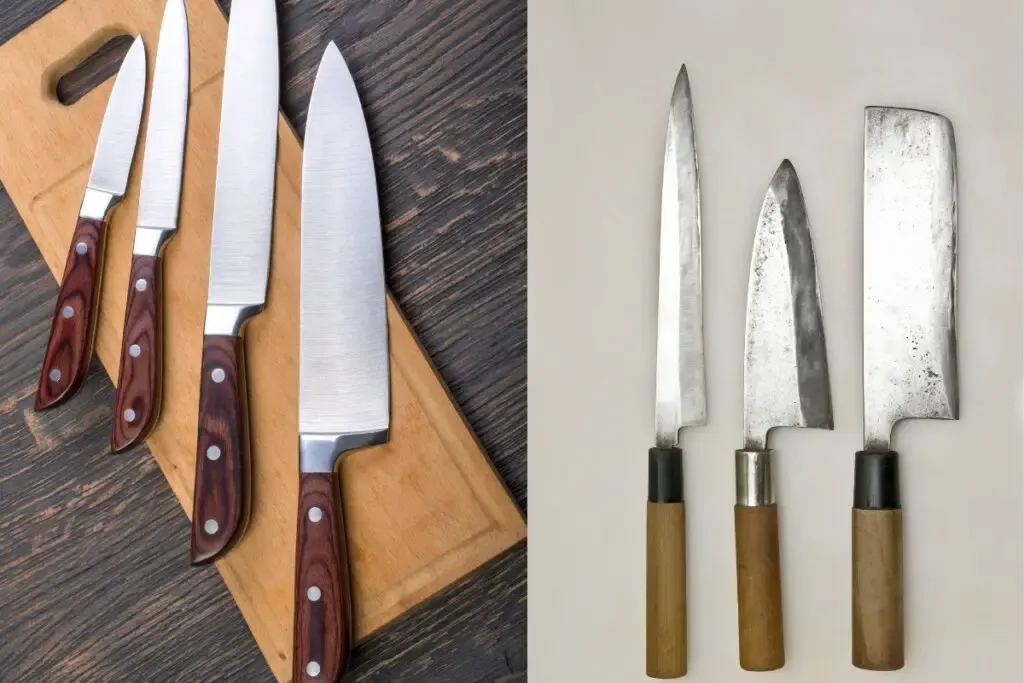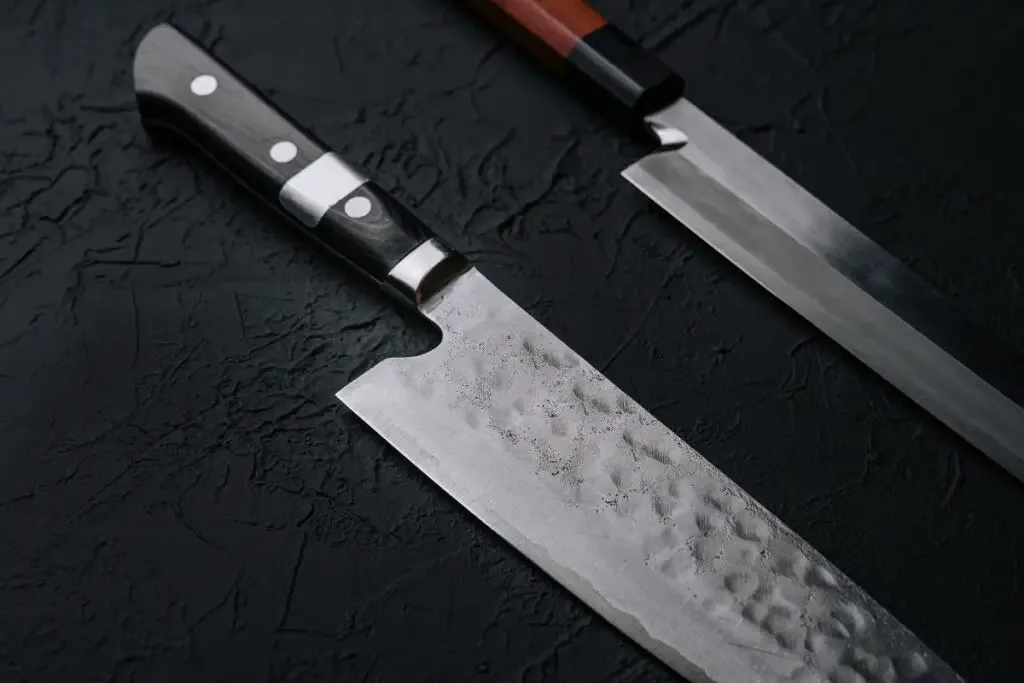As an Amazon Associate, we earn from qualifying purchases with no additional costs for you.
In the culinary world, there is often much debate over what type of knives are better. A chef’s knife or a Japanese-style kitchen knife? The differences between these two types of knives can be difficult to understand for someone who doesn’t work in the industry. One common question that is asked in this regard is about the construction of Japanese knives and whether they have a bolster or not.
Some Japanese knives have a bolster, and some do not. The traditional way handle usually has a buffalo horn bolster to prevent the natural wood from cracking and splitting. Some manufacturers do not include a bolster in their handle design, opting for the plain wood look to the handle.
You will often hear from some sources that Japanese knives do not have a bolster, and this is what differentiates them from Western-style knives. This is, however, not true since some Japanese knives have bolsters, and some do not. What differentiates Japanese knives from Western-style knives is the way the bolster is incorporated into the knife.
If you are interested in checking out the best Japanese knives (made by Hayate Yoshihiro) we recommend and use you can find them by clicking here (Amazon link).

What Is A Bolster?
A bolster is defined as the area where the handle transitions to the blade of the knife, and it differs in style and weight depending on the purpose of the bolster.
In many full tang knives, the bolster is incorporated into the steel and is a part of the original piece of steel that the knife was crafted from.
However, this is not always the case, and sometimes the bolster is made for a completely separate piece of metal, sometimes even brass or copper, and serves as an aesthetic part of the knife construction as well.
The bolster on a knife can have a number of functions depending on the design of the knife. In some knives, it is to protect the front end of the handle and prevent the wood from cracking and splitting.
In other cases, the bolster is intended to alter the balance of the knife and position the knife’s center of gravity for a particular purpose or cutting style.
On some knives, the bolster has an integrated finger guard, which is a safety feature on the knife and is intended to prevent your hand from sliding forward over the blade when you are performing a push cut.
In some knife designs, the bolster is incorporated for the above-mentioned purposes but also created as a decorative component of the knife to improve the aesthetics of the knife and the flow of the lines and design of the knife.
Now that we have discussed what a bolster is and what its purpose is, we can get back to the question of whether Japanese knives have bolsters or not.
TIP: Do knives need a bolster? You will see some knives that incorporate a bolster into their design and others that don’t have one at all. Find out more in the article below:
Do Knives Need A Bolster? Here’s The Explanation
Do Japanese Knives Have Bolsters?

You will find much debate in knife circles about the topic of Japanese knives and bolsters, and many proponents are convinced that Japanese knives do not have bolsters, and this is part of what separates them and sets them apart from knives constructed in the Western world.
Some Japanese knives have bolsters, and some do not incorporate bolsters into their handles. Where a bolster is included in a Japanese knife, it is usually made from buffalo horn and not from metal. This is to preserve the lightness of the handle and keep the weight in the blade.
The point of view that Japanese knives do not have bolsters normally stems from the idea that a bolster is the transition from blade to handle and is made of metal. If this were the full definition of a bolster, then the premise about Japanese knives not having bolsters would be correct.
However, the definition of a bolster does not imply that the bolster is steel, simply that it is a transition area between the blade and handle.
With this definition, there are some Japanese knives that do incorporate a bolster into their knife and handle designs.
Many Western-style knives have handles that are made from resins, synthetic materials, and also resin-stabilized wood. These materials are hard and durable and not prone to cracking and splitting.
The traditional handle material for Japanese knives is natural wood, which is formed over the tang of the knife in a very tight friction fit.
The metal hidden tang part of the knife is often driven into the slot in the handle when the metal is hot, which burns the slot to the size of the tang and makes for an extremely tight fit.
Because the handle material is natural wood, the stresses that are placed on the wood during this type f fitment would often cause the wood to split along the grain, starting at the slot where the knife handle is driven in.
To solve this problem, Japanese knife makers created a bolster made from buffalo horn, which is shaped like a sleeve and fits over the end of the handle where the blade joins the handle.
The addition of the buffalo horn bolsters helped to prevent the wood from cracking and splitting when the knife tang was driven into the handle.
While the bolster was originally only added when the wood used for the handle was of the type that is prone to splitting, it quickly became a design feature, and manufacturers used it as part of a maker’s mark of sorts to distinguish their knives from others.
Some Japanese knife manufacturers do not include a bolster on their handles, even though they continue to use natural wood as the handle material of choice.
The most probable reason for this is that these manufacturers use wood types that are less likely to split when the handle is fitted to the tang of the knife.
For some manufacturers, this bolster-less style has become their standard and is what distinguishes their brand from others.
TIP: Did you know that you can replace the handle on your Japanese knife yourself? In the article below you will find out how!
7 Simple Steps: How To Replace A Japanese Knife Handle
Why Is Metal Not Used As A Bolster In Japanese Knives?

Japanese knives are designed to have the weight of the knife in the blade, making for a blade-heavy knife.
This promotes a grip further back on the handle, and the cut relies on the sharpness of the knife and the weight of the blade pushing through the material rather than the force that is applied to the knife by the user.
To promote the weight of the blade acting to push the extremely sharp cutting edge through the material, the handle of Japanese knives needs to be light, and added weight from a metal bolster would alter the weight distribution and, thus, the balance of the knife.
Western chef knives and kitchen knives have heavy handles but generally have a smaller volume than Japanese knife handles.
This has resulted in most Western-style kitchen knives being handle-heavy in their balance which promotes the use of the knife with a grip closer to the blade of the knife can give more weight to the cut.
The bolster in Western-style knives is often created from metal to correctly balance the knife and have more weight accentuated in the handle rather than the blade.
Because the handles on Japanese knives are made from natural woods, the handles will often not last for the lifespan of the knife and will need replacing.
Ebony, cherrywood, yew, and chestnut are the woods that are often used in handle materials for these knives, but the wood is still porous and can absorb moisture and swell and become loose on the knife if the wood is not cured properly.
A bolster on the handle helps to protect the end-grain of the wood to some extent to limit the moisture that it absorbs.
The handle on Japanese knives is generally not glued into place because it is expected that the handle would need to be replaced at some point in the life of the knife. The friction fit style of the handles makes it easy to remove an old handle from the knife and fit a new handle.
BTW: If you want to know more about Japanese and other knives and their sharpening, check out the books listed above. These books are recommended by professional sharpeners and knife makers (Amazon links):
- Japanese Kitchen Knives: Essential Techniques and Recipes
- The Knifenerd Guide to Japanese Knives
- Knife: The Culture, Craft, and Cult of the Cook’s Knife
- Sharp: The Definitive Introduction to Knives, Sharpening, and Cutting Techniques, with Recipes from Great Chefs
Pros And Cons Of A Bolster On A Knife
There are advantages and disadvantages of including a bolster in a knife design. We have created a table below to comprehensively overview the advantages and disadvantages of having a bolster on a knife.
| Aspect | Pros of Having a Bolster | Cons of Having a Bolster |
| Safety | Provides a finger guard, preventing fingers from sliding onto the blade. | Adds weight to the knife, which might be unwieldy for some users. |
| Balance | It can improve the balance of the knife, especially for larger knives. | It might alter the desired balance for certain cutting techniques. |
| Durability | Reinforces the knife at a critical junction, potentially increasing longevity. | It can complicate the process of sharpening the entire blade edge. |
| Aesthetics | It can enhance the visual appeal and give a more finished look. | Some might find it breaks the clean lines of a minimalist design. |
| Maintenance | Protects the handle, especially if it’s made of wood, from potential damage or splitting. | It can accumulate food particles or debris, requiring more cleaning. |
| Versatility in Cutting | Provides a clear demarcation between handle and blade, aiding in precision cuts. | It might limit the ability to use certain parts of the blade effectively. |
| Weight Distribution | It can add weight to the handle, making the knife handle-heavy for certain tasks. | Adds unnecessary weight for those who prefer blade-heavy knives. |
| Cost | It can add value and justify a higher price due to added material and craftsmanship. | Increases the cost of production, potentially making the knife more expensive. |
The decision to choose one over the other often comes down to personal preference and the specific tasks the knife will be used for.
Conclusion
In summary of this topic, a bolster, or lack thereof, is not a defining factor for a Japanese knife since some of them have bolsters and others do not.
What is a defining factor is that if the knife does have a bolster, it is traditionally made from buffalo horn, not metal, in order to maintain the correct balance between the handle and the blade.
The bolster is not a defining factor for Western-style kitchen knives either since some of these have and some don’t. If they do have a bolster, however, it is generally always metal.
This helps maintain the weight of the knife on the handle side, which promotes the knife action and grip that is intended to be used with Western knives.
TIP: Japanese knives are considered one of the best kitchen knives, but they are also quite expensive. If you are wondering why Japanese knives are worth their price, click the article below!
9 Reasons Why Japanese Knives Are Worth Their Price
